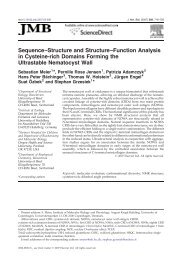Interference between Dipolar and Quadrupolar ... - Biozentrum
Interference between Dipolar and Quadrupolar ... - Biozentrum
Interference between Dipolar and Quadrupolar ... - Biozentrum
You also want an ePaper? Increase the reach of your titles
YUMPU automatically turns print PDFs into web optimized ePapers that Google loves.
<strong>Dipolar</strong> <strong>and</strong> <strong>Quadrupolar</strong> <strong>Interference</strong><br />
A)<br />
-<br />
J. Am. Chem. Soc., Vol. 116, No. 22, 1994 10197<br />
15.0 25.4<br />
A)<br />
1500 1000 500 [Hzl<br />
A<br />
283K<br />
A 258<br />
K<br />
I I I I<br />
120 [Hzl 0 120 El 0<br />
Figure 1. I3C natural abundance spectrum of glycerol-dg at various<br />
temperatures at a magnetic field strength of 600 MHz proton Larmor<br />
frequency: (A) complete spectrum at 333 K, (B) spectral region of the<br />
methine triplet in the temperature range from 333 to 258 K. Spectra<br />
were recorded with the spectrometer in the unlocked mode; therefore, the<br />
frequency reference is arbitrary. A total of 32 transients were recorded<br />
per spectrum.<br />
No change in IH <strong>and</strong> I3C spectra or relaxation times was observed on<br />
these samples over a period of 6 months. NMR experiments were carried<br />
out either on a Bruker AMX600 three-channel spectrometer or on a<br />
Bntker AMX360 two-channel spectrometer. For the numerical lineshape<br />
simulations the software system Mathematica (Wolfram Research Inc.)<br />
was used.<br />
Results<br />
Asymmetric W-*H Triplet. Figure 1A depicts the natural<br />
abundance 13C spectrum of glycerol-dg at 333 K <strong>and</strong> at a magnetic<br />
field strength of 600 MHz proton Larmor frequency. Clearly<br />
visible is the downfield-shifted symmetric triplet of the central<br />
methine carbon. It corresponds to a 20 Hz scalar coupling of the<br />
central spin-1 deuteron to the *3C methine carbon. The two<br />
equivalent methylene carbons, each attached to two equivalent<br />
deuterons, give rise to the symmetric pentuplet in the upfield part<br />
of the spectrum. As the temperature is lowered from 333 to 258<br />
K (Figure lB), the resonance lines become broader until the<br />
methine triplet collapses into a singlet at the TI minimum of<br />
deuterium, at about 293 K. At even lower temperatures the lines<br />
become narrower again, <strong>and</strong> a triplet can be observed <strong>between</strong><br />
278 <strong>and</strong> 268 K. At 258 K, the outer lines of the triplet have<br />
nearly broadened beyond detection. A surprising feature of the<br />
triplet below 293 K is its distinct asymmetry, which at 268 K<br />
amounts to a low-field shift of about 5.2 Hz of the center line<br />
with respect to the center of the outer lines (Figure 2A). At a<br />
magnetic field strength of 360 MHz proton Larmor frequency,<br />
the triplet at 268 K is less well resolved, due to the shorter 2H<br />
TI value. However, a strongly resolution enhanced spectrum<br />
I<br />
150 [Hzl 0<br />
Figure 2. I3C natural abundance spectrum of the methine triplet of<br />
glycerol-dg at 268 K (A) magnetic field strength of 600 MHz proton<br />
Larmor frequency, 2600 averaged transients, (B) magnetic field strength<br />
of 360 MHz proton Larmor frequency, 3072 averaged transients. Digital<br />
resolution enhancement was used to resolve the individual components<br />
of the triplet.<br />
(Figure 2B) shows that the asymmetric shift of the center line<br />
increases to ca. 9 Hz, indicating that the effect is inversely<br />
proportional to the strength of the static magnetic field.<br />
Redfield Theory of the <strong>Dipolar</strong>/<strong>Quadrupolar</strong> <strong>Interference</strong>. As<br />
described below, the asymmetry of the triplet follows in a<br />
straightforward manner from Redfield theory.31 The spin system<br />
can be described by the following Hamiltoniadz<br />
where 7 fs is the spin Hamiltonian <strong>and</strong> %SL(t) the Hamiltonian<br />
of the spin-lattice coupling in the interaction picture. Assuming<br />
cylindrical symmetry for the quadrupolar interaction (asymmetry<br />
parameter 7 = 0), both quadrupolar <strong>and</strong> dipolar spin-lattice<br />
interactions can be expressed in the following form:<br />
2<br />
m=-2 01<br />
where G is a coupling constant, Tm the spin-dependent part of<br />
the interaction, Yzm a second-order spherical harmonic at the<br />
Euler angles Q = (e, 4) representing the orientation with respect<br />
to the external magnetic field of either the internuclear vector in<br />
the dipolar case or the principal axis of the quadrupolar tensor.<br />
The characteristic frequency associated with the interaction<br />
representation of spin operator x", is given by WE. Denoting<br />
dipolar <strong>and</strong> quadrupolar terms by superscripts D <strong>and</strong> Q, the<br />
coupling constants G, spin operators Tm, <strong>and</strong> transition frequencies<br />
cog take the following form:<br />
(31) Redfield, A. G. Adu. Magn. Reson. 1965, I, 1-32.<br />
(32) Goldman, M. Quantum Description of High-Resolution NMR in<br />
Liquids; Clarendon Press: Oxford, 1988; p 236 ff.



